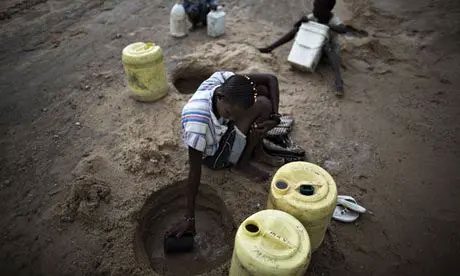According to a reporter in Paris, the French newspaper Les Echos has reported that the ability to convert evaporated seawater into drinking water could help address the issue of drinking water shortages in countries suffering from chronic droughts, which are increasingly exacerbated by climate change. This method could also help meet the high demand for drinking water in various regions and reduce the risks associated with climate change.
This is the result of a study conducted by a team of scientists from the University of Illinois, published in the prestigious scientific journal “Nature”.

Children drinking cooling water in Los Angeles, California, USA, on August 30, 2022. (Photo: AFP/TTXVN)
Extracting drinking water from ocean evaporation is an invention that transforms our understanding of the warming of seawater due to climate change. By explaining the principles and beneficial aspects of the project, the American scientists described the implementation process at offshore extraction facilities capable of capturing and condensing water-saturated air before directing it through pipelines for storage and distribution for use.
According to the researchers, this process is more advantageous than traditional desalination methods because it consumes less energy and has a lower environmental impact. Desalination plants typically discharge pollutants such as brine and wastewater containing heavy metals. Therefore, the American scientists proposed to overcome the disadvantages of conventional desalination processes using a natural chemical principle: By evaporating and converting into gas, seawater vapor naturally loses almost all its salt content. Skipping the salt extraction step also significantly alleviates the mechanisms of seawater alteration related to desalination. Additionally, extraction stations could operate using renewable energy produced by wind turbines.
Mrs. Francina Dominguez, an atmospheric expert and co-author, stated: “This technique recreates the natural water cycle, with the only difference being that we can direct the destination of the evaporated water from the ocean.”
According to calculations by the authors of this study, a vertical capture surface of 210 meters wide and 100 meters high could provide enough moisture to meet the daily drinking water needs of approximately 500,000 people. The researchers obtained this result through simulations at 14 water-stressed locations near major population centers, such as Los Angeles (USA), Rome (Italy), and Chennai (India). Based on their models, this type of device could generate between 37.6 billion and 78.3 billion liters of water per year, depending on the conditions at each site.
The American scientists noted that the cost of building a facility to collect and condense atmospheric vapor is estimated at $600 million, three times the cost of constructing a seawater desalination plant, which is approximately $200 million. However, the scientists believe that there is still room for improvement to reduce costs and increase the operational lifespan of these systems compared to desalination stations, making them more durable.
According to Professor Praveen Kumar of the University of Illinois, a co-author of the study, as the Earth continues to warm, humanity will need to find ways to increase the supply of fresh water, as conserving and recycling existing water sources will not be sufficient to meet demand. He expressed confidence that this proposal could achieve this goal on a large scale.
Meanwhile, Mrs. Afeefa Rahman, another co-author, emphasized: “This method provides an effective and necessary approach to adapting to climate change, especially for vulnerable populations living in arid and semi-arid regions around the world.”

Residents attempting to scoop water from the dry riverbed in Turkana, Kenya. (Illustrative photo: AFP/TTXVN).
According to a recent report by the World Meteorological Organization, a United Nations agency, 3.6 billion people around the world lack access to water for at least one month each year, a number projected to increase to over 5 billion by 2050. One of the main causes is the increasingly prolonged and frequent chronic droughts, particularly in countries in the Horn of Africa, such as Somalia and Ethiopia.


















































